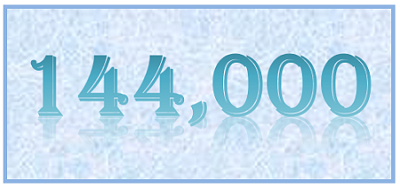August 15, 2005.
Revelation 7 and 14 describe the much-talked-about 144,000. In addition, Rev. 7 pictures “a great multitude.” Though the 144,000 and the great multitude seem to be different, in many respects they are identical:
- Both are before the throne (14:3; 7:15).
- Both are saved, redeemed by the blood (14:4; 7:14).
- Both are clean and pure (14:5; 7:14).
- Both follow the Lamb (14:4; 7:17).
- Both serve God (7:3; 7:15).
All that is said about both groups applies to all true Christians.
What, then, are the differences between the two groups? The major obvious difference is that the 144,000 are Israelites (7:4), while the great multitude is made up of “all nations, and kindreds, and people, and tongues” (7:9). We have here Jewish Christians and Gentile Christians. Because of their characteristics, the first group cannot be unconverted Jews any more than the second group can be unconverted Gentiles.
Some brethren conclude that the 144,000 and the great multitude are actually one and the same group–simply described under different figures. This is a possibility that clearly is in agreement with various Bible texts regarding true Israel. See Insights #34, and #62.
On the other hand, there are those who teach that the 144,000 and the great multitude are two different groups in the sense of having different positions and destinies either in this world or in the world to come. Such a view must be rejected inasmuch as it contradicts sound Bible doctrine. Eph. 4:4 is clear: “There is one body… one hope.” Jew and Gentile Christians are in the same body and have the same hope. Any interpretation of prophecy must be rejected if it denies this simple and basic gospel truth.
Keeping Eph. 4:4 in mind, could there still be some reason to distinguish saved Jews from saved Gentiles? Yes. “The gospel of Christ… is the power of God unto salvation… to the Jew first, and also to the Greek” (Rom. 1:16). The book of Acts amply details the historical fact that, according to Jesus’ plan, Jews were the first to receive salvation. The conversion of Gentiles came later, beginning with Cornelius. Chapter 7 of Revelation could well be based on this reality.
Thus there are two views regarding the 144,000 and the great multitude that agree with sound Bible doctrine:
1. They are two figures of the same group of redeemed souls; or
2. They are two groups, but only in the sense of recognizing the fact that the gospel was first to the Jew and then to the Greek.
How would either of these two views fit into the exact setting of Rev. 7? The 144,000 and the great multitude are mentioned between the sixth seal (Rev. 6:12) and the seventh seal (Rev. 8:1). This is a more difficult study; but those of us who accept the historical interpretation of the book of Revelation believe that chapter seven fits into the time of the great ingathering of saints that took place in the fourth century, after the cessation of the persecution of the church by the Roman Empire. Some believe it could also include the great number saved from the beginning of the Gospel in A.D. 30 up to the fourth century.
Wherever they exactly fit into history, both the 144,000 and the great multitude are obviously pictures of the glorious eternal victory for those who are redeemed by the blood of the Lamb.
